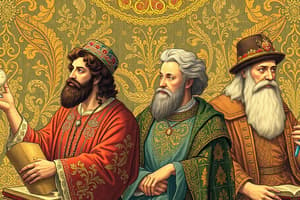Podcast
Questions and Answers
Which theory states that the Earth is at the center of the solar system?
Which theory states that the Earth is at the center of the solar system?
- Copernican Theory
- Newtonian Theory
- Geocentric Theory (correct)
- Heliocentric Theory
John Locke believed that people should submit their rights to a strong ruler.
John Locke believed that people should submit their rights to a strong ruler.
False (B)
Who introduced the first smallpox vaccine?
Who introduced the first smallpox vaccine?
Edward Jenner
Galileo built a telescope and discovered that the moon had a ______ surface.
Galileo built a telescope and discovered that the moon had a ______ surface.
Match the following individuals with their contributions:
Match the following individuals with their contributions:
Flashcards
Geocentric Theory
Geocentric Theory
The theory that the Earth is the center of the solar system.
Heliocentric Theory
Heliocentric Theory
The theory that the Sun is the center of the solar system.
Reformation
Reformation
A period of time when people began to question the teachings of the Church.
Salons
Salons
Signup and view all the flashcards
New Government
New Government
Signup and view all the flashcards
Study Notes
Key Figures in Scientific Revolution and Enlightenment
- Andreas Vesalius: Examined human bodies through dissection to create diagrams of organs, bones, and muscles.
- Edward Jenner: Developed the first smallpox vaccine.
- Gabriel Fahrenheit: Created the first mercury thermometer.
- Galileo: Used a telescope to observe the moon's rough surface.
- Johannes Kepler: Mathematically supported the heliocentric theory.
- John Locke: Believed humans are born free and equal with natural rights (life, liberty, and property).
- Mary Wollstonecraft: Advocated for women's education to advance their virtue and usefulness.
- Montesquieu: Promoted the separation of powers and checks and balances.
- Newton: Visualized the universe as a complex system, governed by natural laws.
- Thomas Hobbes: Proposed that individuals should surrender freedoms to a powerful ruler for order.
- Zacharius Janssen: Invented the first microscope.
Political and Religious Concepts
- Divine Right: The belief that monarchs are chosen by God to rule.
- Geocentric Theory: The theory that the Earth is the center of the solar system.
- Heliocentric Theory: The theory that the sun is the center of the solar system.
- New Government: A system where the government's power derives from the people's consent.
- Old Government: Rule justified by the monarch's divine right.
- Parliament: The highest legislative body in the UK.
- Reformation: A period of religious challenge to established Church doctrine.
- Secular: Relating to non-religious matters.
- Salon: A gathering of intellectuals and artists for discussion and exchange.
Studying That Suits You
Use AI to generate personalized quizzes and flashcards to suit your learning preferences.



